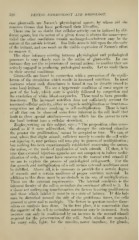Page 516 - My FlipBook
P. 516
526 DENTAL EMBRYOLOGY AND HISTOLOGY. —;
case giant-cells are Nature's physiological agents, by whose aid she
removes tissues that have performed their life-oifice.
There can be no doubt that cellular activity can be induced by dif-
ferent agents, but the action of a given tissue is always the same — pro-
vided the other conditions remain unchanged—whatever may be the
nature of the outside irritant. Too little stress is laid upon the character
of the irritant, and too much on the visible expression of Nature's effort
to remove it.
The close intimacy existing between physiological and pathological
processes is very clearly seen in the action of giant-cells. In one
instance they are the expressions of normal action ; in another they are
actively engaged in producing pathological results. Let us study them
in their several conditions.
Giant-cells are found in connection with a perversion of the equili-
brium of the circulation which results in increased nutrition. In most
instances where such disturbance is found it can be directly traced to
some local irritant. We see a hypersemic condition of some organ or
part of the body, which state is quickly followed by congestion and
the exudation of white blood-corpuscles. These tend to form granula-
tion-tissue. The increased nutrition does not sufficiently account for
increased cellular activity, either as regards multiplication or function
congestion not always resulting in cell-multiplication. There is back
of all that can be observed some force inherent in the cell itself that
leads to these special attributes—an ego which has the power to turn
the local irritant into a cellular stimulant. -
Ziegler, writing on this subject, says : " The proposition, often enun-
ciated as if it were self-evident, 'the stronger the external stinudus
the greater the proliferation,' cannot be accepted as true. We can, at
most, admit that slight stimuli, sufficient merely to excite the cell with-
out injuring it, may perhaps call into play its powers of multiplication ;
but nothing has been experimentally established concerning the nature,
the action, or the mode of application of such stimuli. If, then, it be
true that external injurious agencies are not competent to induce multi-
plication of cells, we must have recourse to the normal vital stimuli if
we are to explain the process of pathological cell-growth. For the
due growth and multiplication of a cell certain external conditions must
be fulfilled. Above all, it is necessary to provide for a certain degree
of warmth and a certain modicum of proper nutritive material. In
addition to this there must be no obstacle in the way of multiplication.
These are the external requirements. The internal condition is the
inherent faculty of the cell to assimilate the nutriment offered to it. In
a tissue not undergoing transformation the factors favoring proliferation
and those which inhibit it must be in a state of balance. If this bal-
ance be disturbed toward the side of the proliferous forces, the cells
proceed to grow and to multiply. The factors in question resolve them-
selves on analysis into three. In the first place, it is conceivable that
the capacity of the cell to assimilate nutriment may be increased. Such
increase can only be conditioned by an increase in the normal stimuli
required for the preservation of the cell. Such stimuli are warmth
for many cells, light; for the muscles, motor impulses; for glands,


